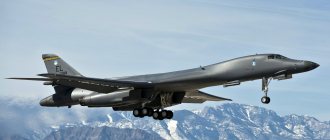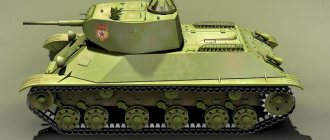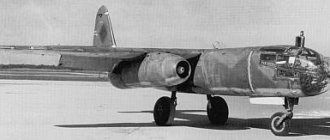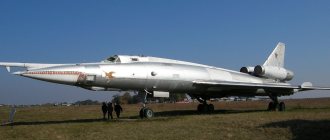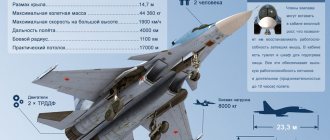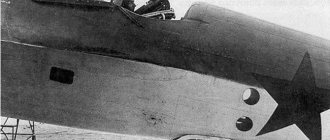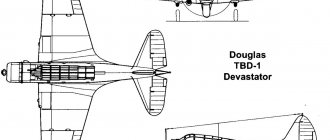Tu-22M3M: why does Russia need an old new bomber?
Back in the USSR
The name of the car alone - Tu-22 - can confuse a person who is not very interested in aviation.
Giving different combat vehicles similar indices has generally become a “good tradition” of the domestic aircraft industry. Let us remember that the very first Tu-22 first took to the skies in 1958. It’s difficult to call this plane successful. During operation, serious shortcomings of the aircraft appeared: at high supersonic speeds, due to air disturbances caused by unsuccessful placement of the engines above the tail, the aircraft became difficult to control. The pilots paid with their lives to bring the plane to completion. The statistics speak for themselves: out of 300 vehicles built, 70 were lost. Built taking into account invaluable experience, the Tu-22M aircraft is, in fact, a completely different machine, which even from a distance is difficult to confuse with an earlier version. The bomber received a mid-mounted variable-sweep wing, air intakes on the sides of the fuselage and engines in the rear (like the Tu-128 interceptor). The next important milestone in the development of the machine was the birth of the Tu-22M3 modification in the 70s. The aircraft, as we know, received more powerful and economical NK-25 engines with an electronic control system ESD-25, as well as a number of other significant improvements, which mainly concerned avionics. The Kh-22 cruise missile and the Kh-15 aeroballistic missile, in principle, provided the aircraft with the ability to hit ground/sea targets without entering the air defense coverage area. However, even during the Cold War, an attack by an American carrier strike group was, one might say, a one-way ticket. The US carrier-based aviation, which had F-14 interceptors at its disposal, would hardly have allowed the Soviet aircraft to return. On the other hand, in the event of a large-scale conflict between the USA and the USSR, this would not matter much anyway: there would simply be nowhere to return.
Resurrection of the plane
As of 2022, Russia had approximately 60 Tu-22M3 bombers. After the collapse of the USSR, some of the aircraft remained on the territory of Ukraine and Belarus, but then these countries abandoned the operation of these machines. It is quite obvious that the aircraft, developed in the 70s, is almost hopelessly outdated, which is obvious, first of all, when considering its avionics. Back in the 80s, they wanted to upgrade the car to the level of the Tu-22M4, but in the early 90s the work was stopped.
In the 2000s, a very strange idea appeared to replace the Tu-22M3 with Su-34 front-line bombers, which were just beginning to enter service with the troops. The absurdity of the concept becomes obvious if you compare the combat radius and load of winged vehicles. The Su-34 is a completely worthy alternative to the Su-24M, but it will not be possible to make a long-range bomber out of it, just as it will not be possible to make one out of the Su-35S or Su-30SM, which use the same base as the Su-34.
A more realistic alternative is the PAK DA, which is now seen both as a bomber and as a reconnaissance aircraft, and even partially as a heavy fighter (it is assumed that it will carry air-to-air missiles). However, the future “invisible” aircraft risks becoming a long-term construction project, because, in fact, it represents the most complex combat aviation complex in the entire history of the USSR/Russia. And also potentially the most expensive. Therefore, the announced date for the first flight (previously stated as the mid-2020s) can be called “optimistic.” The way out of the situation is seen to be upgrading the Tu-160 to the level of the Tu-160M2, the Tu-95MS to the level of the Tu-95MSM and the Tu-22M3 to the level of the Tu-22M3M.
Economics and saving
The United States has long shown how to ideally modernize old bombers. Their B-52H and B-1B received, in particular, the latest Sniper Advanced Targeting Pod sighting systems, as well as the ability to use “smart” and relatively inexpensive bombs using JDAM kits. The modernization itself was not cheap, but the aircraft were able to successfully retrain from doomsday weapons to fighters against terror. Well, or with any enemy of the United States from among the third world countries that do not have serious air defense.
Apparently, the Tu-22M3M cannot boast of such capabilities, although its main purpose lies in a slightly different plane. The use of an aircraft as a carrier of conventional unguided bombs can be considered an anachronism. The effect achieved through this will be small, but the chances of losing the plane increase significantly if we draw an analogy with missile launches from an area outside the range of enemy air defense. In this regard, the loss of the Tu-22M3 bomber during the armed conflict in South Ossetia on August 10, 2008 is indicative.
Therefore, as we have already noted, the main task for the Tu-22M3M is to fight aircraft carrier strike groups and defeat particularly important targets on the ground using cruise missiles. To do this, the vehicle was equipped with a new weapon system, including modern communications and navigation equipment, modern electronic warfare equipment and high-precision X-32 class cruise missiles with a launch range of up to 1000 km and a speed of 4-5.4 thousand kilometers per hour. The rocket itself can be considered as the main, most important innovation of the Tu-22M3M. Alas, the new “long arm” of the bomber can hardly be considered “new” in the usual sense of the word. In fact, we have before us a modernized version of the X-22 missile, which was developed back in the 60s. The samples demonstrated during testing show no signs of reduced radar signature, which, of course, reduces the chances of hitting a target in conditions of intense air defense counteraction. But other new Russian missiles - Kh-101 and Kh-59MK2 - have quite noticeable signs of stealth technology, although it is difficult to say how much this helps in practice.
Another weapon option for the Tu-22M3M is the use of the Kinzhal aeroballistic missile, which is also sometimes called a “hypersonic missile.” The range of use of this product as part of a missile-carrying bomber is estimated at three thousand kilometers, which is certainly a solid indicator. On the other hand, statements about the revolutionary nature of the development itself are far from reality. Conceptually, the “Dagger” is closer to the Soviet X-15 than to the promising hypersonic Boeing X-51, which has a ramjet hypersonic air-breathing engine, allowing it to maintain enormous speed throughout the entire flight phase (which, however, does not solve the problems of aiming the missile at a hypersonic speed).
One of the conditionally positive aspects is the unification of the avionics of the Tu-22M3M with similar systems of the strategic missile carrier Tu-160M. Taking into account the trends that we see in the Russian Air Force (recently there has been talk again about the purchase of the MiG-35 in addition to a variety of Sushkas), any unification is good, although the level of developed Western countries here is also unlikely to be achieved: apparently this is the goal didn't even install it.
In general, the modification of the Tu-22M3M well reflects the economical approach to new weapons characteristic of modern Russia. The bomber is a kind of winged “twin brother” of the T-72B3 main battle tank, which also became a compromise in terms of price/quality ratio. In total, by 2022, it is planned to modernize up to 30 Tu-22M3 to a new level at the Kazan Aviation Plant. By analogy with the Su-27SM fighter, it can be assumed that in the future the remaining part of the aircraft will also be upgraded. And in the foreseeable future, some Tu-22M3M2 or Tu-22M3M3 may appear, designed, among other things, for “Daggers” or new guided bombs.
Tu-22M3 (“45-03”) Multi-mode long-range missile carrier-bomber
History of creation
DESIGN.
The Tu-22M aircraft is made according to a normal aerodynamic design with a variable geometry wing, an all-moving stabilizer and a single-fin vertical tail.
The airframe structure is made mainly of aluminum alloys. The wing consists of a fixed part and rotating consoles (on the Tu-22M3 they can be installed in a position with a sweep angle of 20°, 30° and 65°; on aircraft of earlier modifications the maximum sweep angle is limited to 60°). In the area of the rotary unit there are aerodynamic ridges that prevent air from flowing to the consoles. Slats are installed on the toe of the consoles along the entire span. On the trailing edge there are elevons and three-section flaps, in front of which three-section spoilers are installed. The differentially deflectable horizontal tail provides longitudinal control of the aircraft and duplicates the lateral controls if they fail. POWER POINT.
The Tu-22M3 and Tu-22MR are equipped with the NK-25 DTRDF (2 x 14,500/25,000 kgf).
The engine control system is electric, with hydromechanical duplication. The fuel is placed in integral tanks located in the central part of the fuselage, in the lower part of the fin, in the center section, in the fixed and moving parts of the wing. The total capacity of the tanks is 50,000 liters, refueling is carried out within 25-30 minutes. The APU is located in the fork. In the rear part of the fuselage there are attachment points for two launch boosters. EQUIPMENT.
The aircraft is equipped with a complex of flight navigation equipment, including a high-precision inertial navigation system.
The automatic flight control system ensures flight along a given route while maintaining a programmed profile. The on-board complex includes a digital computer. The Tu-22M3 is equipped with a sighting and navigation system, including a high-power PNA radar (developed by NPO Leninets), and an optical bomber sight with a television channel, capable of being used in the dark and during daylight hours. There is a duplicated INS and radio navigation equipment. Low-altitude flight is ensured by an automatic altitude control system that receives information from a radio altimeter. For remote control of defensive weapons, a radar and television sight are located in the rear fuselage, under the keel. Electronic warfare equipment includes radar reconnaissance and radiation warning systems, active radar jamming systems, devices for ejecting dipole reflectors and heat traps (passive jamming units are located in the area of the rotary stabilizer attachment points). To warn of the approach of enemy missiles, an infrared station with a facet-shaped hemispherical fairing is located in the upper part of the fuselage, behind the cockpit. WEAPONS.
The missile armament of the Tu-22M3 aircraft consists of one (under the fuselage in a semi-recessed position), two (under the wing) or three (overload version) Kh-22MA missiles, designed to destroy large sea and radar-contrast ground targets at ranges of 140-500 km . The launch mass of the rocket is 5900 kg, length is 11.3 m, maximum speed corresponds to M=3. The bomber's armament is supplemented by hypersonic (M=5) short-range aeroballistic missiles X-15, designed to destroy stationary ground targets or enemy radars. Six missiles can be placed in the fuselage on a multi-position drum launcher, another four missiles are suspended on external units under the wing and fuselage. Bomb armament, consisting of conventional and nuclear free-falling bombs with a total mass of up to 24,000 kg, is located in the fuselage (up to 12,000 kg) and on four external hardpoints on nine-lock beam holders MBDZ-U9-502 (typical bomb load options - 69 FAB-250 or eight FAB-1500). In the future, it is possible to arm the Tu-22M3 aircraft with high-precision guided bombs, as well as new missiles for hitting ground and sea targets. Defensive armament - one GSh-23 cannon with a shortened block of barrels mounted vertically and having a rate of fire increased to 4000 rounds/min. Cannon fire control is remote, via television and radar channels.
| Description | ||
| Design | OKB im. A.N.Tupoleva | |
| Designation | Tu-22M3 (“45-03”) | |
| Type | Multi-mode long-range missile carrier-bomber | |
| First flight | June 20, 1977 | |
| Adoption | 1983 | |
| Issue volume | 268 | |
| Crew, people | 4 | |
| Geometric and mass characteristics | ||
| Aircraft length, m | 42,46 | |
| Aircraft height, m | 11,05 | |
| Wingspan, m | x = 20 deg | 34,28 |
| x = 65 degrees | 23,3 | |
| Wing area, m2 | x = 20 deg | 183,57 |
| x = 65 degrees | 175,8 | |
| Take-off weight, kg | maximum | 124000 |
| with starting boosters | 126000 | |
| normal | 112000 | |
| Landing weight, kg | maximum | 88000 |
| normal | 78000 | |
| Fuel weight, kg | 53550 | |
| Power point | ||
| Number of engines | 2 | |
| Engine | DTRDF NK-25 | |
| Engine thrust, kgf | maximum | 14500 |
| afterburner | 25000 | |
| Specific fuel consumption at subsonic levels, kg/kgf*hour | 0,76 | |
| Flight data (calculated) | ||
| Speed, km/h (M=) | maximum | 2000-2300 |
| Max. near the ground | 1050 | |
| cruising | 930 | |
| takeoff | 370 | |
| landing | 285 | |
| Practical ceiling, m | 13300 | |
| Subsonic flight range, km | 7000 | |
| Range with combat load 12 tons, km | at supersonic speed | 1500-1850 |
| at subsonic speed near the ground | 1500-1650 | |
| at subsonic speed along a mixed profile | 2410 | |
| Run length, m | 2000-2100 (370) | |
| Run length, m | 1200-1300 | |
| Armament | ||
| Cruise missiles | 1-3 X-22M | |
| Aeroballistic missiles | 10 X-15 | |
| Bomb load, t | normal | 12 |
| maximum | 24 | |
| Defensive | gun GSh-23 23 mm | |
Information sources:
- Aviation and Cosmonautics No. 2.2000, 8.1999
- “Bombers” / V. Ilyin, M. Levin, 1997 /
- Bulletin of the Air Fleet. March-April 1997.
- "Encyclopedia of Weapons" / "Akella", 1996 - CD-ROM /
- “Encyclopedia of Arms” / “Cyril and Methodius”, 1998 - CD-ROM /
- Tu-22M / Strategic aviation /
- "The Pride of Russia." Aviation photo collection. / Lana-press.CD-ROM, 1997 /
Tu 22 airplane model
In post-war times, rapidly developing, aviation switched from piston engines to jet engines.
Fighters crossed the sound barrier, and the main striking force of aviation - strategic bombers - became vulnerable to new air defense systems, which were replenished with supersonic interceptors and anti-aircraft missile systems (SAM). Therefore, the idea arose to create a supersonic bomber. The Americans were ahead of Soviet designers; they began working on this topic back in the late 40s. The result of their work was the supersonic bomber B-58 Hustler, which took to the skies in November 1956. (a month later he exceeded the speed of sound).
And in the Soviet Union, at that time, the main bomber was the Tu-16. It was loved in combat units for its good flight qualities, reliability and ease of operation. But subsonic speed did not allow him to carry out newly emerging tasks and reach the target, breaking through air defense lines with new weapons. To solve new problems, a supersonic bomber was required. But to create it, a real scientific and technical breakthrough was needed. The task of creating a new machine was entrusted to A.N. Tupolev since his design bureau had extensive experience in designing aircraft for long-range aviation. The new bomber received the designation Project 105. The designers based it on the Tu-16, but after four years of work, nothing remained of its predecessor in the new machine. During this time, dozens of models of the new aircraft were tested, and research was carried out in the field of aerodynamics and materials science. A number of mutually exclusive problems were also solved. For example, it was necessary to increase the speed and increase the flight range. But in supersonic flight mode, fuel consumption increased sharply, while the range was reduced by more than half. A solution was found: approach the target at subsonic speed, then dash at 1.5-2M and return to subsonic mode. This mode was called jumping; it saved fuel and provided the necessary flight range. June 21, 1958 Aircraft 105 made its first flight, but the result disappointed the designers; the machine did not break the sound barrier.
At the same time, in KB A.N. Tupolev, work was underway on a version of a supersonic bomber, designated the 105A aircraft. Based on the latest research in the field of aerodynamics, the fuselage was made somewhat fitted, which made it possible to significantly reduce aerodynamic drag and, as a result, reach supersonic speed. On September 7, 1959, the vehicle entered testing. It immediately became clear that the aircraft had many flight and design features. From the very beginning there were problems with controllability, in one of the test flights of the prototype 105A aircraft, the tail unit supposedly collapsed due to flutter, as a result of which the pilot and navigator were killed. The bomber had a very high landing speed - 330 km/h. In addition, at high speeds the wing began to flutter, so we had to limit the maximum speed to Mach 1.4. Another feature of the new vehicle was the ejection system. The seats did not shoot up as usual, but down, which limited the minimum height for emergency escape from the aircraft. Changes to the design had to be made on production aircraft, since there was no time left for testing. But such was the political situation at that time. Summer 1961 The first stage of joint (military and industrial) testing of the 105A aircraft was completed, which was put into service under the designation Tu-22.
That same summer, a new supersonic bomber was shown at an air parade in Tushino. Tu-22 made a strong impression on the spectators and military attaches of Western states. This was one of the responses to the challenges of the United States during the Cold War. NATO assigned the designation Blinder to the Tu-22, which translated means dazzling; in the Soviet Air Force, the aircraft received the nickname “Shilo” for its characteristic shape. The aircraft was produced in several modifications. The bomber variant was designated Tu-22B, which could carry a 9-ton bomb load. The Tu-22R reconnaissance aircraft was molded from the Tu-22B with photographic equipment installed in the nose and bomb bay. To strike targets from outside the air defense zone and to attack aircraft carrier formations, the Tu-22K missile carrier was created, which was equipped with the latest long-range supersonic cruise missile X-22. Due to its large dimensions, the X-22 missile was suspended under the fuselage in a semi-recessed state. It could be equipped with both conventional and nuclear warheads. To increase the range, the bomber was equipped with a refueling boom. This vehicle received an additional index D (refueling). The maximum range of the Tu-22 bomber has now exceeded 6000 km.
A total of 330 vehicles of various modifications were built, of which, for various reasons, about 70 crashed. This was also due to design flaws and crew errors. The Tu-22 became one of the most dangerous aircraft in domestic aviation, but despite this, it was a very formidable weapon. NATO countries reacted very nervously to the appearance of this bomber in the combat regiment of the Soviet Air Force. The Tu-22 was exported to Libya and Iraq, where it took part in hostilities. The bomber was used to a limited extent by Soviet troops in Afghanistan. As part of our country's long-range aviation and naval aviation, the Tu-22 bomber was in operation until the first half of the 90s. Despite all the inconsistencies, it became an epoch-making machine in the history of the domestic aircraft industry.
Now let's talk about the models of the Tu-22 supersonic bomber. Until recently, the only scaled-down copy of this aircraft was a 1:72 scale model produced by the Italian company ESCI. Even with a quick inspection and comparison with photographs or drawings, serious geometric errors immediately caught the eye. It took a lot of effort to bring it to fruition. And so, at the end of last year, a new development from the Ukrainian company Modelsvit No. 72022 Tu-22KD appeared on the market. Let's look at it now. The model is packed in a cardboard box with a removable top.
Inside are 28 sprues of various sizes made of light gray plastic, a glazing sprue, decal sheet, glazing mask and instructions. The model consists of 320 parts and is made using LND technology, but at a fairly decent level. There is practically no flash, there are almost no sink marks, soapiness or displacements. The surface has a thin and clear internal lining. But it is better to check its copyability from photographs, of which there are plenty today. I was pleased with the execution of the round parts; some of them have a small amount of flash, but there is no displacement of the halves, therefore, they can be used for work.
The division of the fuselage, consisting of three parts, suggests, in the future, the release of other modifications of the bomber.
Bow part.
The interior of the cabins is very well designed, although it’s unlikely that anything will be visible there through the small glazing.
Wings.
There is a relief in the landing gear niches, but there is no wiring or hydraulics, although this is probably good, it is better to reproduce it yourself from wire of various diameters.
The nose strut consists of seven parts, and the main ones - of nine. The landing gear wheels are molded on a separate sprue made of black plastic.
Keel and stabilizers.
Engine parts. It is worth noting here that the nozzles have a somewhat unpronounced relief. In a good way, it is better to replace them, but today no one produces resin nozzles yet. As for the rest, the air intake channels and afterburner chamber are well designed.
The model provides for the possibility of building a variant of the Tu-22 model with powder accelerators.
Litniki with other parts.
As we noted above, we are considering a bomber model of the Tu-22KD modification, so inside there are three sprues of the X-22 missile, presumably these are olives from the Amodel company. They contain parts of the rocket and trolley. Accordingly, the rocket can be made in a suspended position or placed next to the aircraft on a trolley.
There are no complaints about the glazing; all elements are clean and transparent.
The decal consists of two sheets. One with marking elements and technical inscriptions of the Tu-22 aircraft, the second with technical inscriptions of the X-22 missile. There are no complaints about the print quality; all elements are clear and clearly visible. Some technical inscriptions claim to be readable.
The instructions are in booklet form and printed on good paper. The assembly steps are shown clearly and clearly. Colors are shown on the back cover. The three color options are the same - silver with white panels, differing only in identification marks and numbers. In fact, this is the same aircraft No. 63, only at different times. From service at the Ozernoye airfield, during the USSR 80s, to a museum exhibit in the Poltava Museum of Long-Range Aviation.
Among the additions to the Tu-22 model on the market today there are metal air intakes from Miniworld and landing gear wheels from and “Ekipazh”.
The copyability of the new model has not yet been considered, but we can hope that the manufacturer did not make any major mistakes in geometry. It is quite possible that there are some easily removable inaccuracies due to the unification of parts, because, as noted above, the structure of the castings and division presupposes the production of other modifications of the aircraft.
To summarize, we can say with confidence that the Ukrainian company Modelsvit has pleased us with another high-quality product. Although the model is made using LND technology, the level of today's products made using this technology is significantly higher than a few years ago. Therefore, this new product can be recommended even to intermediate level modelers. There are already several examples of perfectly assembled Tu-22KD models from this set on the Internet, and I won’t be wrong if I say they will be a decoration for any collection of modern aviation. One point that is worth considering when purchasing this model is that the dimensions of the assembled aircraft are: length - 592mm, wingspan - 322mm. And of course, a considerable price – about $42.



